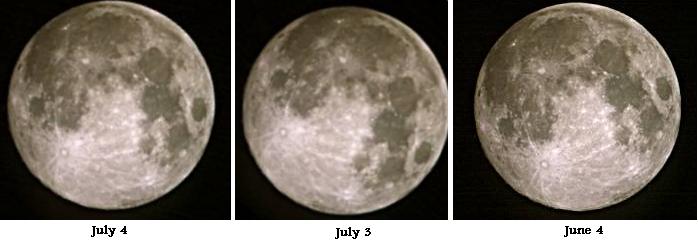
| |
 |
On June 4th I not only was the moon out of position but that it appeared, relative to some photos, to be rotated slightly, about 12 degrees clockwise. This morning [Jul 4], as I was tracking the moon's descent a finally clear, dark sky gave me an incredibly good view of the near full moon about thirty degrees off the horizon. To my surprise the moon had rotated another 10-12 degrees clockwise on its axis.
- June 4
- Here now is the modified picture that demonstrated the angular position of the face of the moon as I observed it on June 4th in the morning. Notice please that the landmark on the right I call the buzzards beak is at 4:00 o'clock and the eye of the buzzard is dead on at 3:00 o'clock.
- July 3
- Here is how the moon appeared this morning, July 3rd, 2004 at approximately 06:30 hours in the Gulf of Mexico. Note now that the Buzzards beak lower jaw is at the 6:00 o'clock position and the eye is at the 4:00 o'clock position.

According to my rough and ready measurements of your first and third images the moon has rotated 41 degrees in about 48 hours. This is not the moon's usual motion! All this makes me wonder where all the astronomers are and what they are not doing? Cat got their tongue? Forced censorship? Are they frozen by non-belief? Are they afraid?
Lunar Libration, does indeed occur, both as a function of the slight wobble that the moon has in its own rotation, as well as a function of the observer moving in relationship to the moon as it appears to pass overhead from rising to setting, called Latitudinal Libration. Movement back and forth across the face of the moon is Longitudinal Libration.
Information that explained the Libration of the moon and it says that the maximum latitudinal libration of the moon is some 7 degrees 7 minutes lattitude. On the face of the moon, that is little more than the movement of 1/2 hour on a clockface. It goes nowhere near explaining an almost 45 degree movement of almost 3 + hours. According to the article on the Libration itself the maximum Latitudinal Libration would be 6 degrees and 50 minutes attributable to the tilt of the earth's plane of the ecliptic relative to the Lunar plane of the ecliptic and 50 minutes of Latitudinal Libration due to diurnal perspective during the moon's travel across the sky of the observer. This would result in a total Latitudinal Libration of a maximum of 7 degrees and 7 minutes, which, as I pointed out above accounts for only about 1/2 hour of what appears to be a nearly 3 hour shift in the latitudinal face of the landmarks on the surface of the moon.